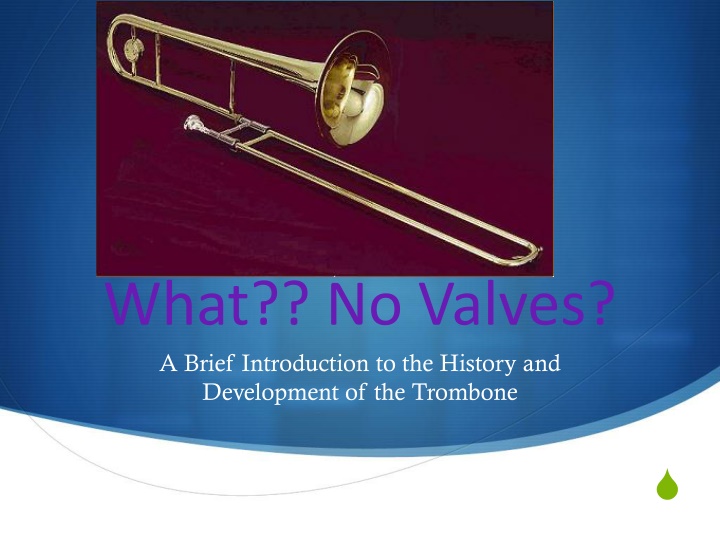
History and Development of the Trombone: A Journey Through Time
Discover the fascinating history and evolution of the trombone, from its early days as a sackbut in the Renaissance to its modern form with a telescopic slide. Learn how the trombone's unique design allowed it to play all 12 chromatic pitches before the invention of valves, making it a versatile instrument across different musical settings.
Download Presentation

Please find below an Image/Link to download the presentation.
The content on the website is provided AS IS for your information and personal use only. It may not be sold, licensed, or shared on other websites without obtaining consent from the author. If you encounter any issues during the download, it is possible that the publisher has removed the file from their server.
You are allowed to download the files provided on this website for personal or commercial use, subject to the condition that they are used lawfully. All files are the property of their respective owners.
The content on the website is provided AS IS for your information and personal use only. It may not be sold, licensed, or shared on other websites without obtaining consent from the author.
E N D
Presentation Transcript
What?? No Valves? A Brief Introduction to the History and Development of the Trombone
The Trombone! The trombone is simply a sliding tube that allows the instrument to change pitch. There are 7 positions on the instrument that allows for a selection of several pitches from low to high in each position. Because of its length, the instrument was folded twice in order to be playable. Like all brass instruments, sound is produced when the player s vibrating lips forming an embouchure that causes the air column inside the instrument to vibrate. The modern trombone is made up of a cylindrical tube shaped into a complex series of tapers, the narrowest near the mouthpiece and the widest towards the bell, (before the flare of the bell starts). The strongest characteristic of the trombone is that it has a telescopic slide by which the trombone player is able to vary the length of the tube and alter the pitch of the notes he or she produces. Like the trumpet, the trombone has a detachable cup-shaped mouthpiece.
The trombone was the only early brass instrument that could play all 12 chromatic pitches over the entire range of the instrument. The trumpet and horn had to wait until the invention of the valve in the early 1800 s to be able to play chromatically over their entire range. According to most music historians, the trombone developed from the Medieval trumpet in three steps: 1. Trumpet makers rediscovered the ancient technique of bending brass tubes. 2. They discovered how to insert a slightly narrower tube inside the first section of the either of these bent trumpets so that the instrument could slide along it and become longer. It was this form that first received the name "trombone." 3. Some maker developed the modern U- shaped slide, in which a pair of straight tubes connected by a bent tube move along the outside of two smaller straight tubes. This form of trombone likely existed some time before 1490
Renaissance Early trombones were called sackbuts , which means push, pull . Because of the ability to play chromatically, the trombone was used to double voice parts in church music. The sackbut was used extensively across Europe from its appearance in the 15th century to a decline in most places by the mid-late 17th century,in outdoor events, in concerts, and in liturgical (church) settings.
Along with trumpeters, trombonists in German city-states were even occasionally employed as civil officials. As officials, these trombonists were often relegated to standing watch in the city towers. However, These trombonists were often viewed separately from the more highly skilled trombonists who played in ensembles that performed in churches such as St Mark's Basilica in Venice in the early 17th century. When the sackbut returned to common use again in England in the 17th century, Italian music was so influential that the instrument became known as the "trombone". The 17th- century trombone was built in slightly smaller dimensions than modern trombones. There are also some solo pieces written specifically for trombone in the early 17th century.
The Baroque All brass instruments operate on the principal of the harmonic series. A solid, tapered tube of a fixed length with a flair at one end will produce only pitches of the series. The Baroque (1600-1750) During the later Baroque period, composers such as Johann Sebastian Bach used trombones on a few occasions.
Classical The construction of the trombone changed relatively little between the Baroque and Classical periods with the most obvious feature being the slightly more flared bell. The use of the trombone in the Classical era was mostly limited to Austria, where the repertoire of trombone solo and chamber literature has its beginnings with composers such as Joseph Haydn and Wolfgang Amadeus Mozart and others, who used the trombones in a number of their sacred (church) works, the best known being in the Tuba Mirum of his Requiem. During the 18th century, the trombone retained its traditional associations with the opera house and the Church. Although not actually the first, the composer typically credited with the trombone's introduction into the symphony orchestra, however, was Ludwig van Beethoven, who used it in the last movement of his Symphony No. 5 in C minor (1808).
Romantic Many composers were directly influenced by Beethoven's use of trombones, and they became fully integrated in the orchestra by the 1840s. The 19th century also saw the erosion of the traditional alto/tenor/bass trombone trio in the orchestra. Romantic Period (1820-1900) The appearance of valve trombones in the mid-19th century did little to alter the make-up of the orchestral trombone section; though it was not used in orchestras in Germany and France, the valve trombone remained popular almost entirely to the exclusion of the slide instrument in countries such as Italy and Bohemia.
The Trombone and 19th-century wind bands Trombones have been a part of the large wind band since its inception as an ensemble during the French Revolution of 1791. Over the course of the 19th century, various wind band traditions were established, including military bands, brass bands (primarily in the UK), town bands (primarily in the US), and circus bands. Toward the end of the 19th century, trombone virtuosi began appearing as soloists in American wind bands. The most notable was Arthur Pryor, who played with the Sousa Band and later formed his own band.
The 20th Century and Beyond! 20th-century orchestras In the 20th century the trombone maintained its important place in the orchestra, and was used extensively by most orchestra composers. \ The trombone and 20th-century wind bands A typical concert band trombone section consists of two tenor trombones and one bass trombone, but using multiple players per part is common practice, especially in public school settings. Modern Bass Trombone:
The Valve Yes the valve had an impact on the trombone, too. Turn the valve allows the air to go through an added section of tubing making the trombone longer and adding a few lower notes. One example is the Thayer valve: The Thayer Valve:
For many people, when they think of the trombone, they think of it as a jazz instrument. In the Dixieland era of jazz in the 1900s the trombone was usually present in "Dixie" groups to assist the bass or tuba player's job of outlining chords for the other instruments to improvise over. It was not until the "Big Band" era of swing came about in the mid-1920s that the trombone began to be used as a solo instrument.
The Trombone in Contemporary Times In the second half of the century, new composers began giving back to the trombone a level of importance in solo and chamber music. Today,. the trombone can be found in wind ensembles/concert band, symphony orchestras, marching bands, military bands, brass bands, and brass choirs. In chamber music, it is used in brass quintets, quartets, or trios, or trombone trios, quartets, or choirs. The size of a trombone choir can vary greatly from five or six to twenty or more members. Trombones are also common in swing, jazz, merengue, salsa, and New Orleans jazz and brass bands. Thank you for Listening!!!






















